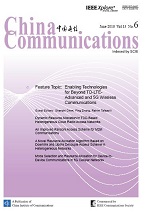CHANNEL CHARACTERIZATION AND MODELING
Rahat Ullah, Bo Liu, Qi Zhang, Qinghua Tian, Amjad Ali, Yousaf Khan, Feng Tian, M. Azam Zia, Haseeb Ahmad, Lijia Zhang, Xiangjun Xin
2016, 13(6): 76-87.
We propose a cost-effective multi-carrier generation technique which minimizes the passive optical access network (PON) costs. In this study replacement of laser array with multi-carrier source at optical line terminal (OLT) side in PON is addressed. With 25-GHz frequency spacing, the generated optical multi-carriers exhibit good tone to noise ratio (TNR) i. e. above 20dB, and least amplitude difference i. e. 1.5dB. At the OLT, multi-carriers signal based multiplexed differential phase shift keying (DPSK) data from all the channels each having 10Gbps for downlink is transmitted through 25km single mode fiber. While the transmitted information is retrieved at optical network unit (ONU), part of the downlink signal is re-modulated using intensity modulated (IM) on-off keying(OOK) for upstream transmission at 10-Gbps. Simulation results are in good agreement with the theoretical analysis, showing error free transmission in downlink and uplink with 10Gbps symmetric data rate at each channel. The received power, both for uplink and downlink transmission, is adequate for all channels at BER of 10-9 with minimum power penalties. Power budget is calculated for different splitting ratios showing excellent system margins for any unseen losses. The proposed setup provides a cost-effective way minimizing transmission losses, and providing greater system’s margin in PON architecture.
